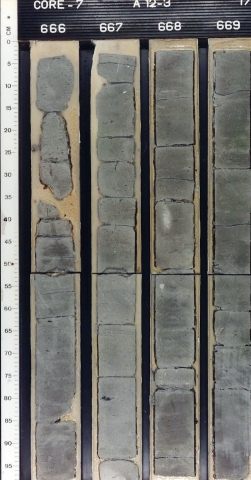Cameron, T.D.J., Bonny, A.P., Gregory, D.M., Harland, R. 1984. Lower Pleistocene dinoflagellate cyst, forminiferal and pollen assemblages in four boreholes in the Southern North Sea. Geological Magazine, 121 (2), 85-97.
Doppert, J.W.Chr., Ruegg, G.H.J., Van Staalduinen, C.J., Zagwijn, W.H., Zandstra, J.G. 1975. Formaties van het Kwartair en Boven-Tertiair in Nederland. In: Zagwijn, W.H., Van Staalduinen, C.J. (eds.): Toelichting bij geologische overzichtskaarten van Nederland. Rijks Geologische Dienst, Haarlem, 11-56.
Gibbard, P.L., Zalasiewicz, J.A., Mathers, S.J. 1998. Stratigraphy of the marine Plio-Pleistocene crag deposits of East Anglia. Mededelingen Nederlands Instituut voor Toegepaste Geowetenschappen TNO, 60, 239-262.
Huizer, J., Weerts, H.J.T. 2003. Beschrijving lithostratigrafische eenheid. Nederlands Instituut voor Toegepaste Geowetenschappen TNO. Utrecht.
Mathers, S.J., Zalasiewicz, J.A. 1988. The Red Crag and Norwich Crag formations of southern East Anglia. Proceedings of the Geologists' Association, 99, 261-278.
Pannekoek, A.J. (ed.) 1956. De geologische geschiedenis van Nederland. Toelichting bij de geologische overzichtskaart van Nederland op de schaal 1:200.000. Staatsdrukkerij- en uitgeverijbedrijf, 's-Gravenhage.
Vernes, R.W., Deckers, J., Bakker, M.A.J., Bogemans, F., De Ceukelaire, M., Doornenbal, J.C., den Dulk, M., Dusar, M., Van Haren, T.F.M., Heyvaert, V.M.A., Kiden, P., Kruisselbrink, A.F., Lanckacker, T., Menkovic, A., Meyvis, B., Munsterman, D.K., Reindersma, R., ten Veen, J.H., van de Ven, T.J.M., Walstra, J., Witmans, N. 2018. Geologisch en hydrogeologisch 3D model van het Cenozoïcum van de Belgisch-Nederlandse grensstreek van Midden-Brabant / De Kempen (H3O – De Kempen). Studie uitgevoerd door VITO, TNO-Geologische Dienst Nederland en de Belgische Geologische Dienst in opdracht van Vlaams Planbureau voor Omgeving, Vlaamse Milieumaatschappij, TNO, Geologische Dienst Nederland, Nederlandse Provincie Noord-Brabant, Brabant Water, Programmabureau KRW/DHZ Maasregio.
Zonneveld, J.I.S. 1958. Litho-stratigrafische eenheden in het Nederlandse Pleistoceen. Mededelingen van de Geologische Stichting, Nieuwe Serie 12, 31-64.
